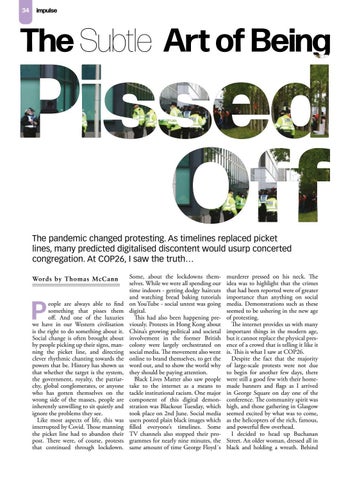34
impulse
The pandemic changed protesting. As timelines replaced picket lines, many predicted digitalised discontent would usurp concerted congregation. At COP26, I saw the truth… Words by Thomas McCann
P
eople are always able to find something that pisses them off. And one of the luxuries we have in our Western civilisation is the right to do something about it. Social change is often brought about by people picking up their signs, manning the picket line, and directing clever rhythmic chanting towards the powers that be. History has shown us that whether the target is the system, the government, royalty, the patriarchy, global conglomerates, or anyone who has gotten themselves on the wrong side of the masses, people are inherently unwilling to sit quietly and ignore the problems they see. Like most aspects of life, this was interrupted by Covid. Those manning the picket line had to abandon their post. There were, of course, protests that continued through lockdown.
Some, about the lockdowns themselves. While we were all spending our time indoors - getting dodgy haircuts and watching bread baking tutorials on YouTube - social unrest was going digital. This had also been happening previously. Protests in Hong Kong about China’s growing political and societal involvement in the former British colony were largely orchestrated on social media. The movement also went online to brand themselves, to get the word out, and to show the world why they should be paying attention. Black Lives Matter also saw people take to the internet as a means to tackle institutional racism. One major component of this digital demonstration was Blackout Tuesday, which took place on 2nd June. Social media users posted plain black images which filled everyone’s timelines. Some TV channels also stopped their programmes for nearly nine minutes, the same amount of time George Floyd´s
murderer pressed on his neck. The idea was to highlight that the crimes that had been reported were of greater importance than anything on social media. Demonstrations such as these seemed to be ushering in the new age of protesting. The internet provides us with many important things in the modern age, but it cannot replace the physical presence of a crowd that is telling it like it is. This is what I saw at COP26. Despite the fact that the majority of large-scale protests were not due to begin for another few days, there were still a good few with their homemade banners and flags as I arrived in George Square on day one of the conference. The community spirit was high, and those gathering in Glasgow seemed excited by what was to come, as the helicopters of the rich, famous, and powerful flew overhead. I decided to head up Buchanan Street. An older woman, dressed all in black and holding a wreath. Behind


























